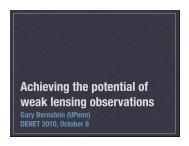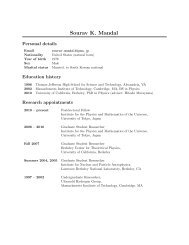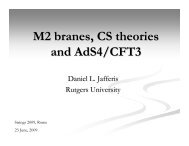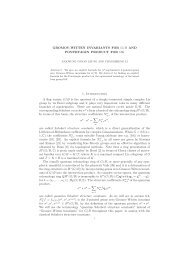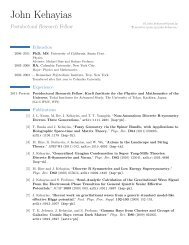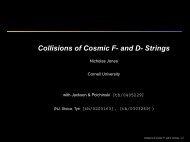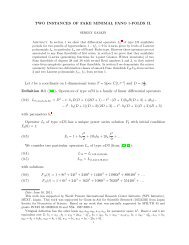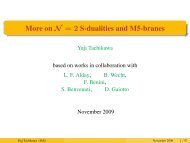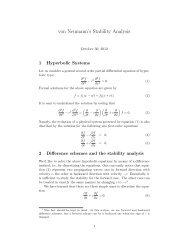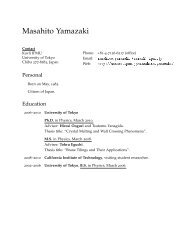STUDY SUMMARY - IPMU
STUDY SUMMARY - IPMU
STUDY SUMMARY - IPMU
You also want an ePaper? Increase the reach of your titles
YUMPU automatically turns print PDFs into web optimized ePapers that Google loves.
<strong>SUMMARY</strong> REPORT<br />
WIDE FIELD FIBER-FED OPTICAL<br />
MULTI-OBJECT SPECTROMETER (WFMOS)<br />
3.0 Instrument Description<br />
3.1 Rationale<br />
The overriding factors in designing WFMOS for the science applications discussed in Section<br />
2 are the need for survey speed and positioner reliability.<br />
With the 8.2-m aperture of Subaru, emission line galaxies in the redshift range 0.7 < z < 1.6<br />
can yield sufficient signal to noise for a reliable redshift in only 15 minutes. This places stringent<br />
demands on the overhead for each exposure, and particularly that associated with reconfiguring<br />
2,400 fibers for a subsequent field.<br />
In the course of conducting the surveys discussed earlier, WFMOS will reconfigure itself<br />
over 3,000 times. Reliability of positioning and robustness of fiber units are key considerations.<br />
In this section we present an instrument design that we believe represents a major improvement<br />
over that discussed in the Feasibility Study. The key advantages are:<br />
• A positioner system that can reconfigure itself to the required precision in under 40 s.<br />
Each fiber is maneuvered at its tip, eliminating the need for tilting. The stout design of<br />
each unit leads to a robust system.<br />
• A set of three high-efficiency spectrographs based on a Schmidt optical design, which<br />
offers an unrivalled combination of light beam area and acceptance solid angle at the<br />
detector (the A-Omega product). Recognizing the long-term utility of WFMOS, our<br />
spectrograph design can accommodate a range of gratings, each of which can be tilted,<br />
offering full flexibility in survey design.<br />
• State-of-the-art, deep-depletion CCD detectors, ensuring optimal efficiency at red<br />
wavelengths for extending redshift surveys beyond z ~1.3 and measuring stellar dynamics<br />
using the Ca II triplet.<br />
3.2 Instrument Overview<br />
WFMOS is a fiber-fed spectrograph designed to be mounted at the prime focus of the Subaru<br />
telescope located on the summit of Mauna Kea, Hawaii. The instrument allows simultaneous<br />
low-resolution spectral observations of up to 2,400 astronomical targets. In high-resolution<br />
mode, WFMOS can observe 600 simultaneous targets.<br />
The instrument system comprises several components. A block diagram appears in Figure<br />
3.2-1. We summarize here the basic function of the components and their interactions; individual<br />
components are described in greater detail in following sections.<br />
WFMOS comprises components mounted in several locations. System elements required to<br />
be at the prime focus of the telescope make up the Prime Focus Instrument (PFI) and are housed<br />
within a Prime Focus Unit (PFU). The three spectrographs, along with their detectors and support<br />
systems, will be located in a spectrograph room adjacent to the telescope, above the Nasmyth<br />
focus.<br />
WFMOS will use several Subaru provided elements that are being developed for the Hyper-<br />
SuprimeCam (HSC) instrument. These include the HSC Field Rotator, Hexapod, structure,<br />
and a Wide Field Corrector (WFC).<br />
18



